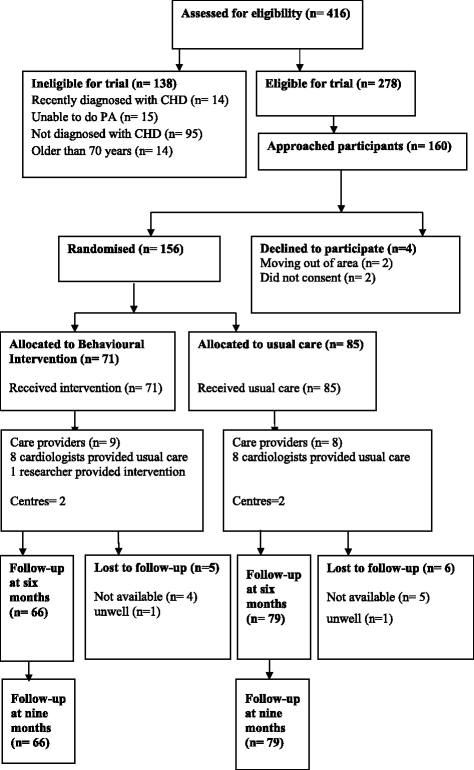Behavioural intervention to increase physical activity in adults with coronary heart disease in Jordan
- PMID: 27460675
- PMCID: PMC4962414
- DOI: 10.1186/s12889-016-3313-5
Behavioural intervention to increase physical activity in adults with coronary heart disease in Jordan
Abstract
Background: Patients with coronary heart disease often do not follow prescribed physical activity recommendations. The aim of this study was to assess the efficacy of a behavioural intervention to increase physical activity in patients with coronary heart disease not attending structured cardiac rehabilitation programmes.
Methods: Parallel randomised controlled trial comparing 6-month multi-component behavioural change intervention (n = 71) with usual care (n = 85) was conducted in two hospitals in Jordan, Middle East. Intervention included one face-to-face individualised consultation, 6 telephone support calls (for goal-setting, feedback and self-monitoring) and 18 reminder text messages. Patients were randomly allocated to the two groups by opening opaque sealed sequence envelopes. The patients and the researcher who provided the intervention and assessed the outcomes were not blinded. Outcomes were assessed at baseline and 6 months. Primary outcome was physical activity level, secondary outcomes were blood pressure, body mass index, exercise self-efficacy for exercise and health-related quality of life.
Results: Intervention and control groups were comparable at baseline. Moderate physical activity significantly increased in the intervention group compared with control group (mean change (SD) of frequency: 0.23 (0.87) days/week versus -.06 (0.40); duration: 15.53 (90.15) minutes/week versus -3.67 (22.60) minutes/week; intensity: 31.05 (105.98) Metabolic equivalents (METs) versus 14.68 (90.40) METs). Effect size was 0.03 for moderate PA frequency, 0.02 for moderate PA duration and 0.01 for moderate PA intensity. Walking significantly increased in the intervention group compared with control group (mean change (SD) of frequency: 3.15 (2.75) days/week versus 0.37 (1.83) days/week; duration: 150.90 (124.47) minutes/week versus 24.05 (195.93) minutes/week; intensity: 495.12 (413.74) METs versus14.62 (265.06) METs). Effect size was 0.36 for walking frequency, 0.05 for walking duration, 0.32 for walking intensity and 0.29 for total PA intensity. Intervention participants had significantly lower blood pressure, lower body mass index, greater exercise self-efficacy and better health-related quality of life at 6 months compared with controls.
Conclusions: Multi-component behavioural intervention increases physical activity, and improves body composition, physiological and psychological outcomes in CHD patients not attending structured rehabilitation programmes.
Trial registration: Current Controlled Trials retrospectively registered in 21-03-2012. ISRCTN48570595 .
Keywords: Behavioural; Coronary heart disease; Intervention; Physical activity; Self-efficacy.
Figures
Similar articles
-
The role of a behavioural medicine intervention in physiotherapy for the effects of rehabilitation outcomes in exercise-based cardiac rehabilitation (ECRA) - the study protocol of a randomised, controlled trial.BMC Cardiovasc Disord. 2017 May 25;17(1):134. doi: 10.1186/s12872-017-0557-7. BMC Cardiovasc Disord. 2017. PMID: 28545400 Free PMC article. Clinical Trial.
-
Behavioural intervention to increase physical activity among patients with coronary heart disease: protocol for a randomised controlled trial.Int J Nurs Stud. 2012 Dec;49(12):1489-93. doi: 10.1016/j.ijnurstu.2012.07.004. Epub 2012 Jul 26. Int J Nurs Stud. 2012. PMID: 22840639 Clinical Trial.
-
Physical Activity after Cardiac EventS (PACES) - a group education programme with subsequent text-message support designed to increase physical activity in individuals with diagnosed coronary heart disease: study protocol for a randomised controlled trial.Trials. 2018 Oct 4;19(1):537. doi: 10.1186/s13063-018-2923-x. Trials. 2018. PMID: 30286797 Free PMC article.
-
Exercise-based cardiac rehabilitation for adult patients with an implantable cardioverter defibrillator.Cochrane Database Syst Rev. 2019 Feb 12;2(2):CD011828. doi: 10.1002/14651858.CD011828.pub2. Cochrane Database Syst Rev. 2019. PMID: 30746679 Free PMC article.
-
Behavioural modification interventions for medically unexplained symptoms in primary care: systematic reviews and economic evaluation.Health Technol Assess. 2020 Sep;24(46):1-490. doi: 10.3310/hta24460. Health Technol Assess. 2020. PMID: 32975190 Free PMC article.
Cited by
-
Effectiveness of digital health interventions for telemedicine/telehealth for managing blood pressure in adults: a systematic review and meta-analysis.Hypertens Res. 2025 Feb;48(2):478-491. doi: 10.1038/s41440-024-01792-7. Epub 2024 Jul 9. Hypertens Res. 2025. PMID: 38977877
-
The effect of behaviour change interventions on changes in physical activity and anthropometrics in ambulatory hospital settings: a systematic review and meta-analysis.Int J Behav Nutr Phys Act. 2021 Jan 7;18(1):7. doi: 10.1186/s12966-020-01076-6. Int J Behav Nutr Phys Act. 2021. PMID: 33413512 Free PMC article.
-
Behavioral change interventions, theories, and techniques to reduce physical inactivity and sedentary behavior in the general population: a scoping review.BMC Public Health. 2024 Aug 3;24(1):2099. doi: 10.1186/s12889-024-19600-9. BMC Public Health. 2024. PMID: 39097741 Free PMC article.
-
Text Message Interventions for Physical Activity: A Systematic Review and Meta-Analysis.Am J Prev Med. 2020 Jan;58(1):142-151. doi: 10.1016/j.amepre.2019.08.014. Epub 2019 Nov 21. Am J Prev Med. 2020. PMID: 31759805 Free PMC article.
-
A cross-sectional study on adult lifestyle habits during the COVID-19 pandemic.PLoS One. 2024 May 20;19(5):e0299668. doi: 10.1371/journal.pone.0299668. eCollection 2024. PLoS One. 2024. PMID: 38768244 Free PMC article.
References
-
- World Health Organization (WHO) Global strategy on diet, physical activity and health. Geneva: World Health Organization (WHO); 2004.
-
- Arrigo I, Brunner-LaRocca H, Lefkovits M, Pfisterer M, Hoffmann A. Comparative outcome one year after formal cardiac rehabilitation: the effects of a randomized intervention to improve exercise adherence. Eur J Cardiovasc Prev Rehabil. 2008;15(3):306–311. doi: 10.1097/HJR.0b013e3282f40e01. - DOI - PubMed
Publication types
MeSH terms
Associated data
LinkOut - more resources
Full Text Sources
Other Literature Sources
Medical


